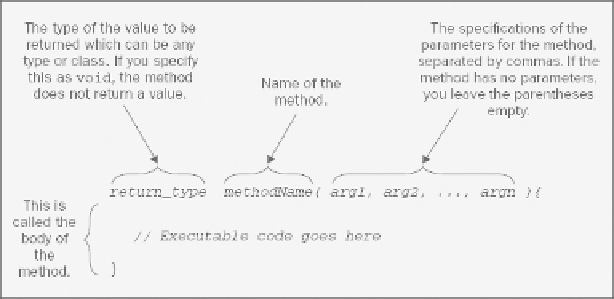Java Reference
In-Depth Information
ically when the object is created. Fields of numeric types are initialized with zero, fields of type
char
are
initialized with '
\u0000
,' and fields that store class references or references to arrays are initialized with
null
.
There has to be something missing from the definition of the
Sphere
class — there is no way to set the
value of
radius
and the other instance variables after a particular
Sphere
object is created. There is nothing
to update the value of
count
either. Adding these things to the class definition involves using methods, so
the next step is to understand how a method is put together.
DEFINING METHODS
You have been producing versions of the
main()
method since Chapter 1, so you already have an idea of
how a method is constructed. Nonetheless, I'll go through how you define methods from the beginning to
make sure everything is clear.
Let's start with the fundamental concepts. A
method
is a self-contained block of code that has a name and
has the property that it is reusable — the same method can be executed from as many different points in a
program as you require. Methods also serve to break up large and complex calculations that might involve
many lines of code into more manageable chunks. You execute a method by
calling
it using its name, and
the method may or may not return a value when its execution finishes. Methods that do not return a value
are always called in a statement that just specifies the call. Methods that do return a value are usually called
from within an expression, and the value that is returned by such a method is used in the evaluation of the
expression. If a method that returns a value is called by itself in a statement — in other words, not in an
expression — then the value it returns is discarded.
The basic structure of a method is shown in
Figure 5-2
.
When you specify the return type for a method, you are defining the type for the value that is returned by
the method when you execute it. The method must always return a value of this type. To define a method
that does not return a value, you specify the return type as
void
. Something called an
access attribute
can
optionally precede the return type in a method definition, but I'll defer looking into this until later in this
chapter.
The
parameters
to a method appear in its definition between the parentheses following the method name.
These specify what information is to be passed to the method when you execute it, and the values that you

